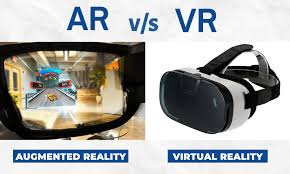
As immersive technologies continue to evolve, two terms often come up in conversation: Augmented Reality (AR) and Virtual Reality (VR). While they might sound similar, they offer very different experiences and have distinct applications. By 2025, both AR and VR are shaping industries like gaming, education, healthcare, and retail—but understanding their differences is key to grasping their potential.
So, what exactly sets AR and VR apart? Let’s break down the technology, user experience, and real-world uses of each to see how they complement—and differ from—each other.
1. What Is Augmented Reality (AR)?
Augmented Reality overlays digital content on the real world. Instead of fully immersing you in a computer-generated environment, AR adds layers of information, images, or sounds onto your actual surroundings.
You experience AR through:
- Smartphones and tablets (think Pokémon GO or Snapchat filters)
- Smart glasses or headsets (like Microsoft HoloLens or Magic Leap)
- Heads-up displays in cars or industrial equipment
In AR, the real world stays central—digital elements enhance it by providing useful data or interactive visuals.
2. What Is Virtual Reality (VR)?
Virtual Reality creates a completely immersive, computer-generated environment that replaces your physical surroundings. When you put on a VR headset, you’re transported to a 3D virtual world that can be realistic or fantastical.
VR experiences require:
- Dedicated headsets (such as Oculus Quest, HTC Vive, or PlayStation VR)
- Sometimes additional gear like hand controllers or treadmills for interaction and movement
In VR, the real world disappears, and you’re fully inside a simulated environment—whether it’s a game, a training program, or a virtual meeting room.
3. Key Differences Between AR and VR
| Aspect | Augmented Reality (AR) | Virtual Reality (VR) |
|---|---|---|
| Environment | Enhances real world with digital overlays | Creates fully virtual world |
| Equipment | Smartphones, tablets, smart glasses | Headsets, gloves, motion trackers |
| Immersion Level | Partial—real world still visible | Full immersion—real world blocked out |
| Mobility | Often mobile and lightweight | Usually stationary or limited movement |
| Use Cases | Navigation, maintenance, retail, education | Gaming, training simulations, therapy |
4. Real-World Applications of AR
Augmented Reality is already transforming everyday life and business:
- Retail: Try on clothes or makeup virtually before buying.
- Healthcare: Surgeons overlay patient scans during operations.
- Manufacturing: Workers get real-time instructions overlaid on machinery.
- Education: Interactive 3D models enhance learning in classrooms.
- Navigation: AR apps display directions and points of interest on your smartphone camera.
AR blends digital convenience with real-world practicality.
5. Real-World Applications of VR
Virtual Reality excels where total immersion is needed:
- Gaming and Entertainment: Fully immersive virtual worlds for play and socializing.
- Training and Simulation: Pilots, soldiers, and medical professionals practice skills safely.
- Therapy: VR helps treat phobias, PTSD, and pain management through controlled environments.
- Virtual Workspaces: Remote teams meet in shared virtual offices, enhancing collaboration.
VR creates experiences impossible in the physical world.
6. The Future: Blurring the Lines
By 2025, the boundaries between AR and VR are increasingly blending with emerging technologies like Mixed Reality (MR) and Extended Reality (XR).
- MR combines AR and VR elements, letting digital objects interact realistically with the real world.
- XR is an umbrella term covering all immersive tech, including AR, VR, and MR.
We can expect devices that seamlessly switch between augmented and virtual experiences, offering new ways to learn, work, and play.
Final Thoughts
Augmented Reality and Virtual Reality are both reshaping how we interact with digital content—but they do so in fundamentally different ways. AR enhances the world we live in, adding useful layers and information, while VR offers a full escape into immersive digital realms.
Together, these technologies offer powerful tools for entertainment, education, business, and beyond. Understanding their differences helps us appreciate their unique strengths and imagine a future where digital and physical realities blend like never before.
